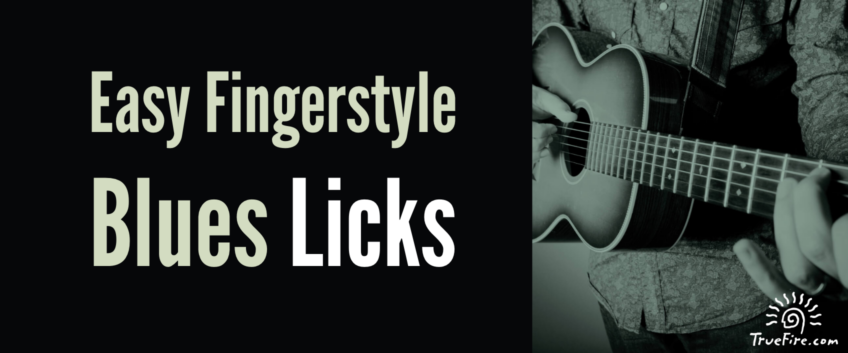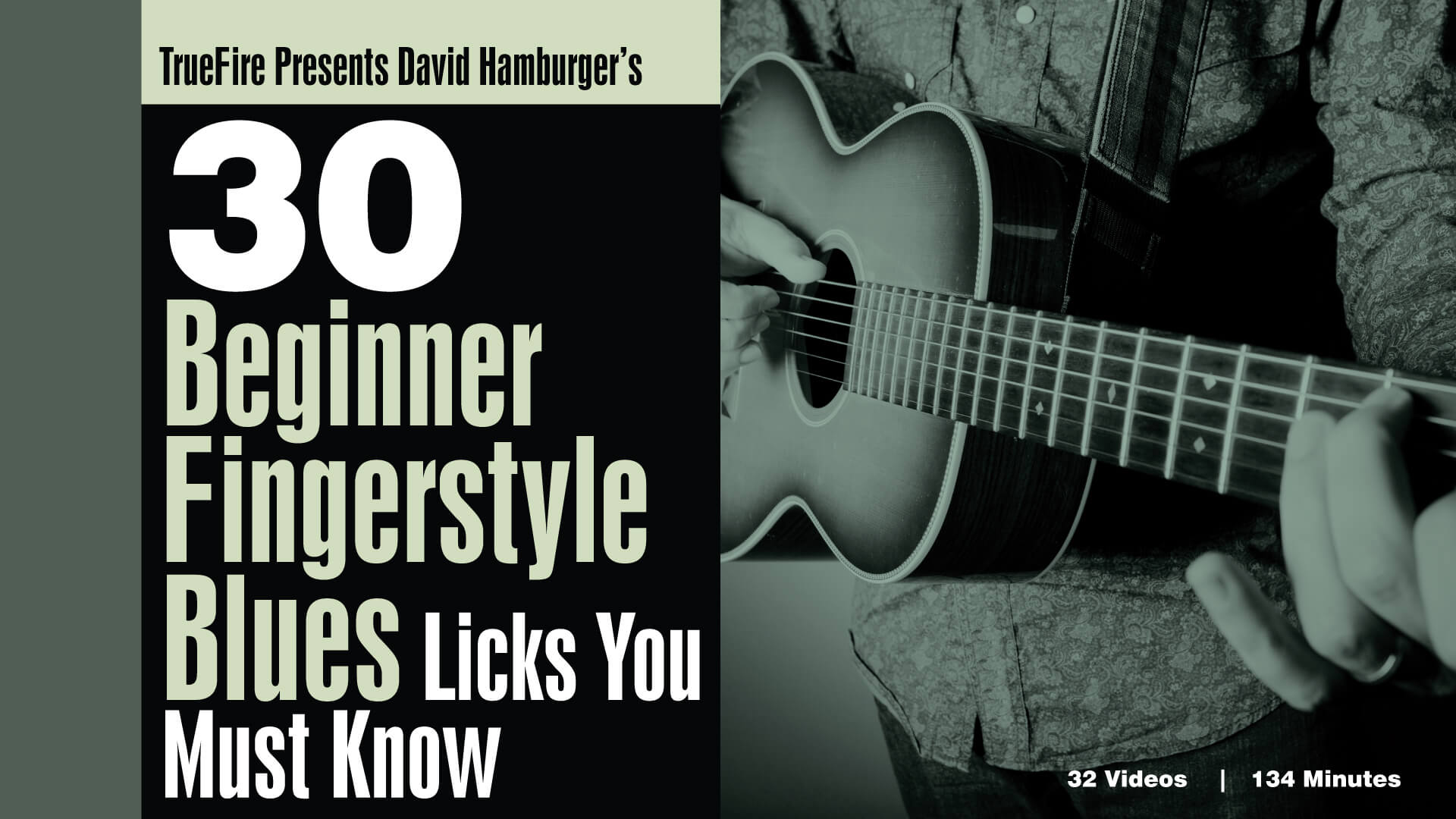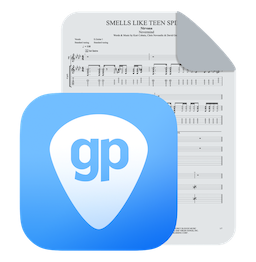
[BLUES] Free beginner fingerstyle licks with tablatures
When guitarists gather they often like to play the blues, it’s usually the easiest way to play together and have fun. You can perform these very easy blues songs with or without a band as you are playing the bass and the melody simultaneously. These videos and their tablatures are offered by Truefire.com. Have fun!
“Blues_Licks”
(click on the picture to download the .zip file with 10 Guitar Pro 7 files)
BLUES LICK 1
“Blues_Lick_1”
(click on the picture to download the Guitar Pro 7 file)
Where would we be without the pentatonic scale?
As one of the few Greek words in my vocabulary, I really treasure the word “pentatonic”. Five notes. Everyone says all you need is three chords and the truth, but for fingerstyle blues, it’s more like five notes and your thumb.
We’re going to see a lot our friend David playing the pentatonic scale in this course, most often in the open position.
BLUES LICK 2
Right-hand coordination is kind of the whole bowl of queso at this stage of the game, so it’s worth taking the time with this first handful of licks to really groove on keeping time with your thumb and paying close attention to how your fingers synchronize with it.
(Queso, for the uninitiated, is a Tex-Mex thing of which, like snowflakes, there is an infinite variety, if snowflakes were something served molten, in a bowl, with tortilla chips and 33º Fahrenheit Lone Star.)
“Blues_Lick_2”
(click on the picture to download the Guitar Pro 7 file)
BLUES LICK 3
Hammer-ons, pull-offs, and slides all work great in the open position, and they’re a big part of creating a fluid fingerstyle sound. They’re also great techniques to bring back into the electric realm, too. Some of my favorite electric players make extensive use of the open position, and these three articulations are integral to the styles of Freddie King, Earl Hooker, and – if you count capo’d playing as open position playing, which I do – Albert Collins and Gatemouth Brown.
BLUES LICK 4
Along with note choice, phrasing rules. Phrasing is a pretty flexible concept; it can mean the literal rhythm of a phrase you play, the way you choose to string together one or more short ideas, or simply the personality of your approach – the way you apply your dynamics, attack, tone, and so on to those musical phrases and ideas.
The pickup phrases in this lick are definitely on the essential list of Cool Concepts You Can Apply Immediately to Sound More Musical.
BLUES LICK 5
When it comes to which finger to use on which string (index, middle, or ring), I still go by the approach I learned from Ken Perlman’s classic book Fingerstyle Guitar: index finger for the third string, middle for the second string, and ring finger for the high string.
There will be constant exceptions, but starting with a default like this will take a lot of the guesswork out of your right hand, and that in turn will speed up your progress considerably.
BLUES LICK 6
The blues scale has all the same notes as the minor pentatonic scale – R, b3, 4, 5, b7 – with the b5 added. In the key of A, the b5 is Eb, that note we’re grabbing at the fourth fret on the second string in this lick. Whether you look at the blues scale as its own thing or as a minor pentatonic scale with one note added is up to you. I do realize semantics isn’t everybody’s bag by a long shot.
BLUES LICK 7
I have to admit that, of the zillions of records Lightnin’ Hopkins made, I’m pretty partial to the solo ones. If you want an immediate sense of the direct connection between the kind of pentatonic soloing we usually associate with electric blues, and the solo fingerstyle approach, you need go no further than Hopkins’ Live At Newport, which also opens with a pretty groovy spoken introduction to the man by none other than Mike Bloomfield.
BLUES LICK 8
The 12/8 or triplet feel here is one of the essential blues grooves, and shows up most often as the classic slow blues feel. But 12/8 is also the pulse in piano-driven New Orleans rhythm & blues and early rock ‘n’ roll – just think about Fats Domino doing “Blueberry Hill” and you’ll have the 12/8 feel so stuck in your head it’ll still be there when you’re brushing your teeth tomorrow morning.
BLUES LICK 9
Together with hammer-ons and slides, pull-offs are key to making your playing sound smoother. And for playing faster things down the line, not having to play every note with your picking hand is one of the big secrets to executing slick uptempo moves on the blues. Just check out open-position masters like Earl Hooker, Lonnie Mack, or Gatemouth Brown – these guys are all about the left hand articulations.
BLUES LICK 10
This lick is built on two fundamental blues tools, the quarter-tone bend and the double stop. A quarter tone bend is a bend that raises a note only half as far as a half-step or one-fret bend – in other words, to a note that falls between the frets, one you can’t even get to without bending.
A double stop just means playing two notes at once, most often on adjacent strings.
The full lesson is available on Truefire.com

(Click on the picture to purchase the complete lesson on TrueFire.com)
Leave a comment
Your email address will not be published.
| Title | Artist | |
|---|---|---|
Hotel California

|
The Eagles | |
| Sing | Ed Sheeran | |
| Never Gonna Give You Up | Rick Astley | |
| BWV 147 - Jesu, Joy of Man's Desiring | Johann Sebastian Bach | |
High School Never Ends

|
Bowling for Soup |



2 Comments
Blues is a heaven’s sound. Thanks for sharing.
The display did improve.
I remember the previous effect, I can directly pull it up or down
But now I have to click in a small place, it ’s really bad
I have been looking forward to your improvement on this point, but no
I love guitar pro